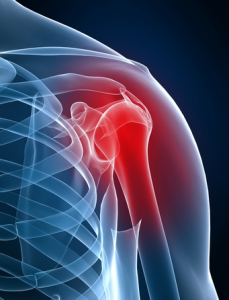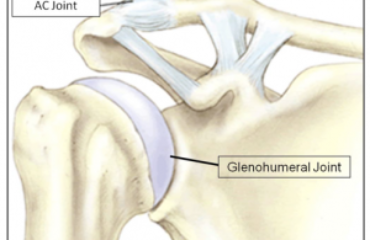The shoulder is a ball and socket joint, with the round portion of the upper arm bone (humerus) fitting into the socket, which is a groove in the shoulder blade. With a dislocated shoulder, the entire rounded ball comes out of the socket. A partially dislocated shoulder involves only part of the ball coming out of the socket, and this is called subluxation.
Most shoulder dislocations occur following a fall or a sports injury. Tendons connect muscles to bones, and ligaments connect bone to bone.  With a shoulder dislocation, muscles, tendons, and/or ligaments become stretched or torn. The symptoms include swelling and bruising of the shoulder, as well as numbness, tingling, and/or weakness of the fingers, hand, arm, and shoulder.
With a shoulder dislocation, muscles, tendons, and/or ligaments become stretched or torn. The symptoms include swelling and bruising of the shoulder, as well as numbness, tingling, and/or weakness of the fingers, hand, arm, and shoulder.
Re-Injury: Dislocation or Subluxation
If a person dislocated the shoulder for the first time, he or she will probably not require surgery. The emergency room doctor will “reduce” or relocate the arm back into the shoulder socket. However, once a patient suffers a dislocation, the likelihood of re-injury is high. The shoulder may continue to partially or fully dislocate with future activities, so surgery is necessary to tighten and repair the tendons and ligaments so the joint is stable.
Rotator Cuff Weakness
Once common problem after a shoulder dislocation is the risk for rotator cuff weakness. The tendons and ligaments of the shoulder joint will become weak and brittle, especially among people over the age of 40 years. Baseball players, tennis players, and swimmers are at great risk for this type of injury. With rotator cuff weakness, the shoulder will hurt, feel weak with activity, and make a clicking or cracking sound with movement.
Damaged Nerves
A shoulder dislocation can stretch the network of nerves called the brachial plexus. These nerves conduct signals for movement and pain from the spine to the shoulder, hand, and arm. With a brachial plexus injury (damaged nerves), there can be temporary shoulder paralysis and permanent shoulder weakness.
Blood Vessel Injury
Some patients who dislocated the shoulder suffer damage to the blood vessels. This problem is more likely to occur in older adults, with artery injuries related to dislocations being the most common injury. Artery damage results in pale skin, low body temperature, bruising, and pain.
Swelling
After a dislocated shoulder, the patient often experiences swelling and bruising of the joint. To relieve this, the patient is advised to:
- Keep the arm in a sling (close to the body)
- Use ice packs for 20 minutes several times each day
- Avoid use or movement
- Avoid rings or tight clothing
Pain
Once common problem following a shoulder dislocation is shoulder pain. For pain, the doctor usually recommends:
- NSAIDS – Nonsteroidal anti-inflammatory drugs, such as naproxen or ibuprofen
- Use of ice or heat to relieve discomfort
- Avoiding activities
The shoulder is the most moveable joint in the human body, allowing rotation of the arm, lifting of the arm, and reaching overhead. Because his joint turns in so many directions, there is a greater risk for instability. Shoulder instability occurs when the shoulder is dislocated, meaning it is vulnerable to repeat dislocations. Chronic shoulder instability is a common problem following dislocation.
Decreased Activity
Following a shoulder dislocation, decreased mobility is expected. This means the patient cannot return to full level of functioning for a while. The patient will have to use a sling to immobilize the arm, use physical therapy for strengthening and mobility. As the shoulder heals, the patient will increase function of the shoulder tendons, ligaments, and muscles. Full recovery takes up to six months, however.
One of the top shoulder specialists in Phoenix is Dr. Adam Farber. He is Board Certified and an expert in treating rotator cuff and shoulder instability issues.
Most insurance is accepted at Phoenix Shoulder and Knee, call (480) 219-3342 today!
Resources
Horn AE, Ufberg JW. Management of common dislocations. In: Roberts JR, Hedges JR, eds. Roberts & Hedges’ Clinical Procedures in Emergency Medicine. 6th ed. Philadelphia, PA: Elsevier Saunders; 2013:chap 49.
Leggin BG, Gaunt BW, Schaffer MA. Rehabilitation of Shoulder instability. Skirven TM, ed. In: Rehabilitation of the Hand and Upper Extremity 6th ed. Philadelphia, PA: ElsevierMosby; 2011:chap 92.



